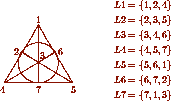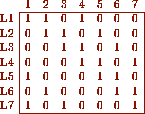![[Shownotes]](../gif/annotate/shide-21.gif)
 lines and
lines and  points such that
points such that






Figure 3: A Graeco-Latin square of Order 4
In 1938, Bose [4] explained why there is no projective plane of order 6. He related the existence of a finite projective plane of order n to the existence of a hyper-Graeco-Latin square. The term ``Graeco-Latin square'' originated with Euler in 1782. In our modern terminology, they are called orthogonal Latin squares. Let us define them.


Figure 4: A Latin square orthogonal to those in Fig. 2
 matrix satisfying the
following properties:
matrix satisfying the
following properties:
 and
and  denote two Latin
squares of order n. They are said to be orthogonal provided that
the
denote two Latin
squares of order n. They are said to be orthogonal provided that
the  2-samples
2-samples  for
for  are distinct. A simple way to visualize the definition is to put the
second square, slightly shifted, on top of the first square. The resulting
n by n array of 2-samples has no repeated entries, and is often
referred to as a Graeco-Latin square or an Euler square.
[an error occurred while processing this directive]
Figure 2 contains two examples of Latin squares of order 4.
They are orthogonal and the resulting Graeco-Latin square is shown in
Fig. 3. Is there a third Latin square orthogonal to both
the squares in Fig. 2? Yes, there is one, as shown in
Fig. 4. Can one find a fourth? The answer is no. One can
easily prove the following theorem [26, p. 80,].
are distinct. A simple way to visualize the definition is to put the
second square, slightly shifted, on top of the first square. The resulting
n by n array of 2-samples has no repeated entries, and is often
referred to as a Graeco-Latin square or an Euler square.
[an error occurred while processing this directive]
Figure 2 contains two examples of Latin squares of order 4.
They are orthogonal and the resulting Graeco-Latin square is shown in
Fig. 3. Is there a third Latin square orthogonal to both
the squares in Fig. 2? Yes, there is one, as shown in
Fig. 4. Can one find a fourth? The answer is no. One can
easily prove the following theorem [26, p. 80,].


If equality holds in (1), then the orthogonal set is said to be complete. Finally, we are ready to state Bose's result [26, p. 92,].


Why does Bose's result explain the non-existence of a projective plane of order 6? It states that such a plane exists if and only if there exists a complete set of 5 mutually orthogonal Latin squares of order 6. The possible existence of even a pair of orthogonal Latin squares of order 6 was a much older problem.
 . He further remarked that the characteristic of
an officer was determined by the two letters, one Latin and the other
Greek, and that the problem consists of arranging the 36 combinations of
two letters in a square in such manner that every row and every column
contains the six Latin as well as the six Greek letters. This was the
origin of the term ``Graeco-Latin square''. Euler observed that the first
step was to arrange the Latin letters in a square so that no letter was
missing either from any row or from any column. He called this square a
Latin square. If he had chosen to arrange the Greek letters instead, then
we would probably have Graeco squares rather than Latin squares. In any
case, if we label both the ranks and the regiments from 1 through 6, then
Euler's problem reduces to the construction of a pair of orthogonal Latin
squares of order 6.
[an error occurred while processing this directive]
. He further remarked that the characteristic of
an officer was determined by the two letters, one Latin and the other
Greek, and that the problem consists of arranging the 36 combinations of
two letters in a square in such manner that every row and every column
contains the six Latin as well as the six Greek letters. This was the
origin of the term ``Graeco-Latin square''. Euler observed that the first
step was to arrange the Latin letters in a square so that no letter was
missing either from any row or from any column. He called this square a
Latin square. If he had chosen to arrange the Greek letters instead, then
we would probably have Graeco squares rather than Latin squares. In any
case, if we label both the ranks and the regiments from 1 through 6, then
Euler's problem reduces to the construction of a pair of orthogonal Latin
squares of order 6.
[an error occurred while processing this directive]
 . This is
the famous Euler's conjecture. The first case n = 2 is trivially
impossible. Tarry around 1900 [27] verified by a systematic
enumeration that Euler's conjecture holds for n = 6. Since there does
not exist even a pair of orthogonal Latin squares, Bose's result implies
the non-existence of a projective plane of order 6.
[an error occurred while processing this directive]
Yet, there is something unpleasant about a systematic hand enumeration: it
is messy and it is error prone. Mathematicians did find a better
explanation in the celebrated Bruck-Ryser theorem [7], which
was published in 1949.
. This is
the famous Euler's conjecture. The first case n = 2 is trivially
impossible. Tarry around 1900 [27] verified by a systematic
enumeration that Euler's conjecture holds for n = 6. Since there does
not exist even a pair of orthogonal Latin squares, Bose's result implies
the non-existence of a projective plane of order 6.
[an error occurred while processing this directive]
Yet, there is something unpleasant about a systematic hand enumeration: it
is messy and it is error prone. Mathematicians did find a better
explanation in the celebrated Bruck-Ryser theorem [7], which
was published in 1949.


Since  and it is not a sum of two integer
squares, the Bruck-Ryser theorem implies the non-existence of a projective
plane of order 6. How did they prove the theorem? We will not repeat it
here, but one of the crucial steps involved the use of an incidence
matrix.
and it is not a sum of two integer
squares, the Bruck-Ryser theorem implies the non-existence of a projective
plane of order 6. How did they prove the theorem? We will not repeat it
here, but one of the crucial steps involved the use of an incidence
matrix.


Figure 5: An incidence matrix for the plane of order two
 of a projective plane of order
n is an
of a projective plane of order
n is an  by
by  matrix where the columns represent the
points and the rows represent the lines. The entry
matrix where the columns represent the
points and the rows represent the lines. The entry  is 1 if point
j is on line i; otherwise, it is 0. For example,
Fig. 5 gives the incidence matrix for the projective
plane of order 2. In terms of an incidence matrix, the properties of being
a projective plane are translated into:
is 1 if point
j is on line i; otherwise, it is 0. For example,
Fig. 5 gives the incidence matrix for the projective
plane of order 2. In terms of an incidence matrix, the properties of being
a projective plane are translated into:

 where
where  denotes the transpose of the matrix A, I denotes the
identity matrix, and J the matrix of all 1's. Every diagonal entry on
the right hand side of Eq. (2) is n+1, which implies that
the inner product of any row of A with itself is n+1 or, equivalently,
its row sum is n+1. Every off-diagonal entry is 1, which is the same
as requiring the inner product of any two distinct rows of A to be 1.
Ryser also proved that A is a normal matrix [25]; in other
words,
denotes the transpose of the matrix A, I denotes the
identity matrix, and J the matrix of all 1's. Every diagonal entry on
the right hand side of Eq. (2) is n+1, which implies that
the inner product of any row of A with itself is n+1 or, equivalently,
its row sum is n+1. Every off-diagonal entry is 1, which is the same
as requiring the inner product of any two distinct rows of A to be 1.
Ryser also proved that A is a normal matrix [25]; in other
words,

 Hence, Eq. (2) also implies the conditions regarding column
sums and column inner products. The Bruck-Ryser theorem starts from this
equation and proves that it implies n is a sum of two integer squares
when
Hence, Eq. (2) also implies the conditions regarding column
sums and column inner products. The Bruck-Ryser theorem starts from this
equation and proves that it implies n is a sum of two integer squares
when  .
[an error occurred while processing this directive]
It is surprising that the Bruck-Ryser theorem has a partial converse
[13].
.
[an error occurred while processing this directive]
It is surprising that the Bruck-Ryser theorem has a partial converse
[13].

 Of course, if the matrix A is actually the incidence matrix of a
projective plane, then it must have entries which are either 0 or 1.
Although this theorem guarantees only a matrix with rational entries, it
suggests that the necessary part of the Bruck-Ryser theorem is very close
to being also sufficient.
Of course, if the matrix A is actually the incidence matrix of a
projective plane, then it must have entries which are either 0 or 1.
Although this theorem guarantees only a matrix with rational entries, it
suggests that the necessary part of the Bruck-Ryser theorem is very close
to being also sufficient.
 , a plane of order 10
would exist if the necessary condition of the Bruck-Ryser theorem is also
sufficient. On the other hand,
, a plane of order 10
would exist if the necessary condition of the Bruck-Ryser theorem is also
sufficient. On the other hand,  , and so, if one
believes Euler's conjecture, then it does not exist.
, and so, if one
believes Euler's conjecture, then it does not exist.
First, Euler's conjecture was shown to be false. In 1959, Bose and Shrikhande [5] constructed a pair of orthogonal Latin squares of order 22. Then Parker [23,24] constructed a pair of orthogonal Latin squares of order 10. Together they showed that Euler's conjecture is false for all orders greater than six [6]. This raised the hope for the existence of a plane of order 10.
History indicated that significant advances were made when one branch of
mathematics was shown to be related to a different branch of mathematics.
It is not surprising that the beginning of the end of the plane of order
10 occurred when people started studying the binary error-correcting code
associated with it.